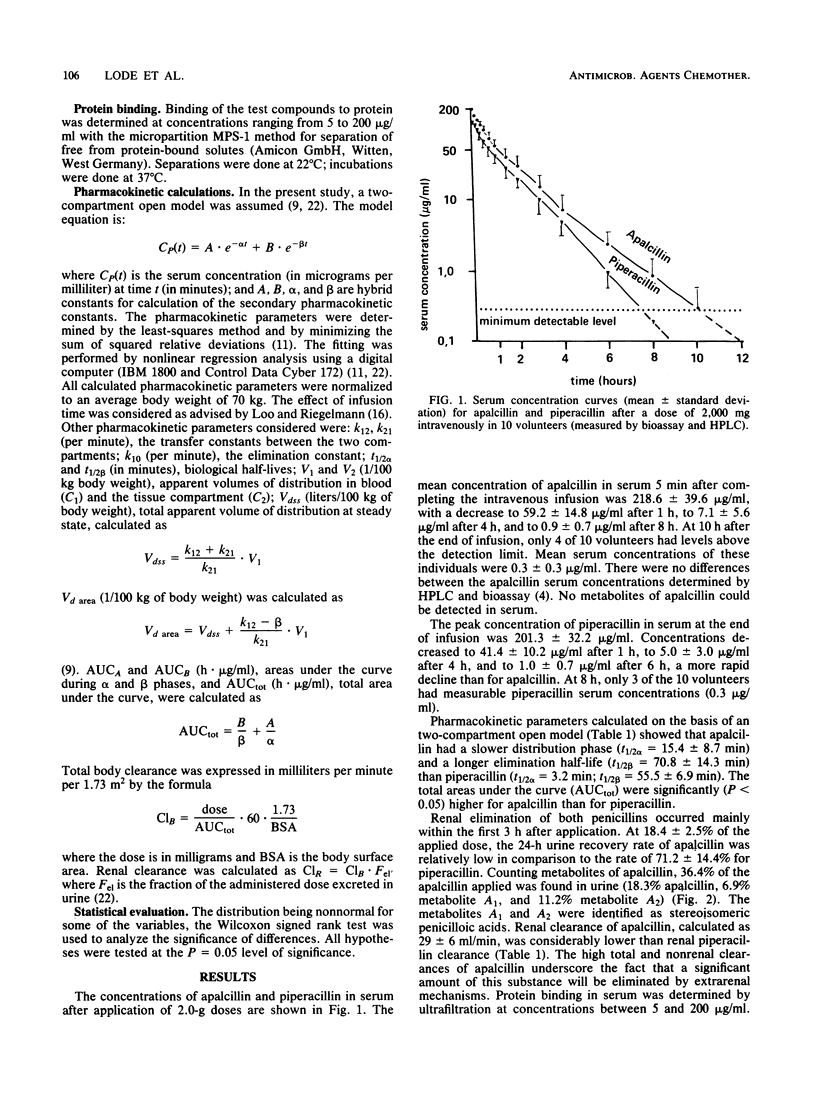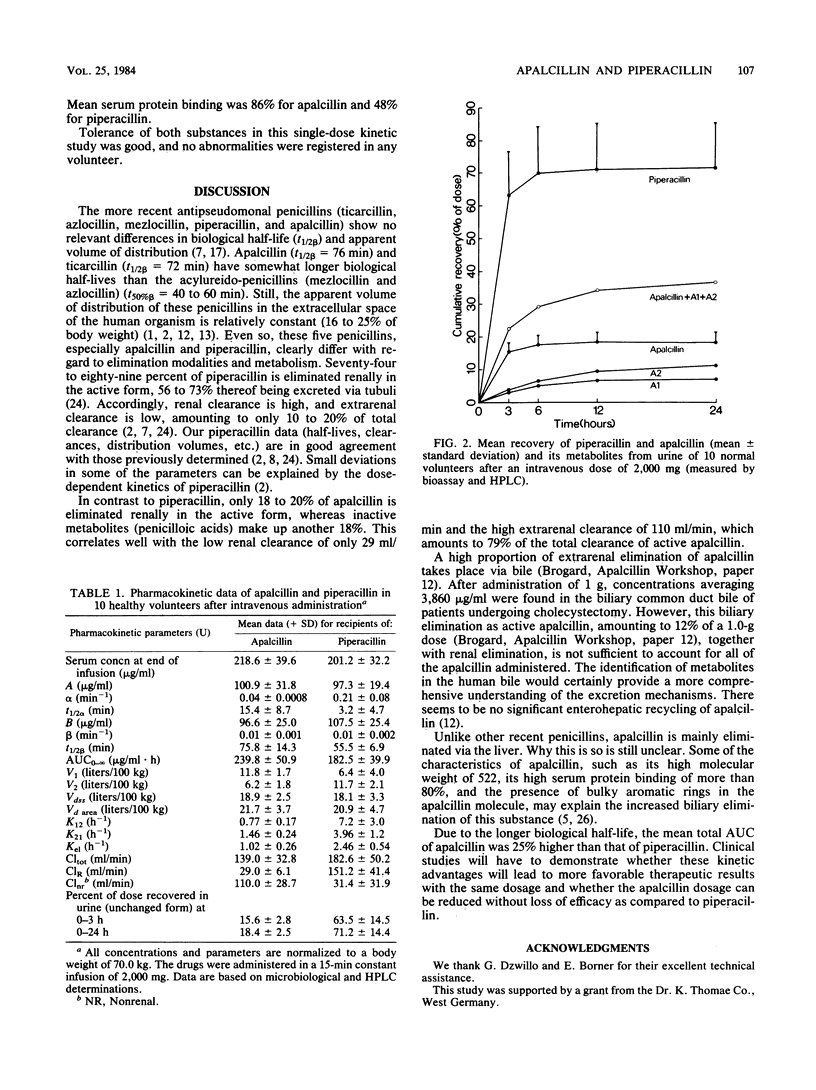Abstract
The pharmacokinetics of apalcillin and piperacillin, each administered intravenously as a single 2-g dose, were compared in 10 volunteers in a randomized study of crossover design using bioassay and high-pressure liquid chromatographic procedures. The concentrations of both penicillins in serum were determined over a period of 12 h and in urine over 24 h. Concentrations of apalcillin and piperacillin at the end of the 15-min infusion were similar; however, at 8 h, concentrations of piperacillin were below measurable levels, whereas concentrations of apalcillin were still measurable at 10 h. Pharmacokinetic parameters were calculated according to a two-compartment open model. The area under the curve and the half-life for apalcillin were larger than for piperacillin. On the other hand, renal clearance of piperacillin was substantially greater than that of apalcillin. Of the apalcillin excreted via the kidneys, approximately one-fifth was eliminated as two microbiologically inactive penicilloic acid derivatives. The nonrenal clearance of apalcillin was 79% of total clearance. Binding of apalcillin to serum protein was almost twice that of piperacillin.
Full text
PDF



Selected References
These references are in PubMed. This may not be the complete list of references from this article.
- Bergan T. Penicillins. Antibiot Chemother (1971) 1978;25:1–122. doi: 10.1159/000401058. [DOI] [PubMed] [Google Scholar]
- Bergan T., Williams J. D. Dose dependence of piperacillin pharmacokinetics. Chemotherapy. 1982;28(3):153–159. doi: 10.1159/000238070. [DOI] [PubMed] [Google Scholar]
- Bodey G. P., Weaver S., Pan T. PC-904, a new semisynthetic penicillin. Antimicrob Agents Chemother. 1978 Jan;13(1):14–18. doi: 10.1128/aac.13.1.14. [DOI] [PMC free article] [PubMed] [Google Scholar]
- Borner K., Lode H., Elvers A. Determination of apalcillin and its metabolites in human body fluids by high-pressure liquid chromatography. Antimicrob Agents Chemother. 1982 Dec;22(6):949–953. doi: 10.1128/aac.22.6.949. [DOI] [PMC free article] [PubMed] [Google Scholar]
- Busch U., Heinzel G., Seyfarth H., Mielenz H. Untersuchungen zur Pharmakokinetik von Apalcillin beim Menschen. Arzneimittelforschung. 1982;32(9):1131–1135. [PubMed] [Google Scholar]
- Eliopoulos G. M., Moellering R. C., Jr Azlocillin, mezlocillin, and piperacillin: new broad-spectrum penicillins. Ann Intern Med. 1982 Nov;97(5):755–760. doi: 10.7326/0003-4819-97-5-755. [DOI] [PubMed] [Google Scholar]
- Evans M. A., Wilson P., Leung T., Williams J. D. Pharmacokinetics of piperacillin following intravenous administration. J Antimicrob Chemother. 1978 May;4(3):255–261. doi: 10.1093/jac/4.3.255. [DOI] [PubMed] [Google Scholar]
- Greenblatt D. J., Kock-Weser J. Drug therapy. Clinical Pharmacokinetics (first of two parts). N Engl J Med. 1975 Oct 2;293(14):702–705. doi: 10.1056/NEJM197510022931406. [DOI] [PubMed] [Google Scholar]
- Greenwood D., Eley A. A turbidimetric study of the responses of selected strains of Pseudomonas aeruginosa to eight antipseudomonal beta-lactam antibiotics. J Infect Dis. 1982 Jan;145(1):110–117. doi: 10.1093/infdis/145.1.110. [DOI] [PubMed] [Google Scholar]
- Koeppe P., Hamann C. A program for non-linear regression analysis to be used on desk-top computers. Comput Programs Biomed. 1980 Dec;12(2-3):121–128. doi: 10.1016/0010-468x(80)90058-6. [DOI] [PubMed] [Google Scholar]
- Leroy A., Humbert G., Godin M., Fillastre J. P. Pharmacokinetics of azlocillin in subjects with normal and impaired renal function. Antimicrob Agents Chemother. 1980 Mar;17(3):344–349. doi: 10.1128/aac.17.3.344. [DOI] [PMC free article] [PubMed] [Google Scholar]
- Lode H., Stahlmann R., Koeppe P. Comparative pharmacokinetics of cephalexin, cefaclor, cefadroxil, and CGP 9000. Antimicrob Agents Chemother. 1979 Jul;16(1):1–6. doi: 10.1128/aac.16.1.1. [DOI] [PMC free article] [PubMed] [Google Scholar]
- Loo J. C., Riegelman S. Assessment of pharmacokinetic constants from postinfusion blood curves obtained after I.V. infusion. J Pharm Sci. 1970 Jan;59(1):53–55. doi: 10.1002/jps.2600590107. [DOI] [PubMed] [Google Scholar]
- Meyers B. R., Hirschman S. Z., Strougo L., Srulevitch E. Comparative study of piperacillin, ticarcillin, and carbenicillin pharmacokinetics. Antimicrob Agents Chemother. 1980 Apr;17(4):608–611. doi: 10.1128/aac.17.4.608. [DOI] [PMC free article] [PubMed] [Google Scholar]
- Neu H. C., Labthavikul P. In vitro activity of apalcillin compared with that of other new penicillins and anti-Pseudomonas cephalosporins. Antimicrob Agents Chemother. 1982 Jun;21(6):906–911. doi: 10.1128/aac.21.6.906. [DOI] [PMC free article] [PubMed] [Google Scholar]
- Noguchi H., Eda Y., Tobiki H., Nakagome T., Komatsu T. PC-904, a novel broad-spectrum semisynthetic penicillin with marked antipseudomonal activity: microbiological evaluation. Antimicrob Agents Chemother. 1976 Feb;9(2):262–273. doi: 10.1128/aac.9.2.262. [DOI] [PMC free article] [PubMed] [Google Scholar]
- Noguchi H., Kubo M., Kurashige S., Mitsuhashi S. Antibacterial activity of apalcillin (PC-904) against gram-negative bacilli, especially ampicillin-, carbenicillin-, and gentamicin-resistant clinical isolates. Antimicrob Agents Chemother. 1978 May;13(5):745–752. doi: 10.1128/aac.13.5.745. [DOI] [PMC free article] [PubMed] [Google Scholar]
- Stille W., Helm E., Mielenz H. Untersuchungen zur antibakteriellen Aktivität von Apalcillin. Arzneimittelforschung. 1982;32(9):1128–1130. [PubMed] [Google Scholar]
- Tjandramaga T. B., Mullie A., Verbesselt R., De Schepper P. J., Verbist L. Piperacillin: human pharmacokinetics after intravenous and intramuscular administration. Antimicrob Agents Chemother. 1978 Dec;14(6):829–837. doi: 10.1128/aac.14.6.829. [DOI] [PMC free article] [PubMed] [Google Scholar]
- Verbist L. Comparison of the activities of the new ureidopenicillins piperacillin, mezlocillin, azlocillin, and Bay k 4999 against gram-negative organisms. Antimicrob Agents Chemother. 1979 Aug;16(2):115–119. doi: 10.1128/aac.16.2.115. [DOI] [PMC free article] [PubMed] [Google Scholar]


